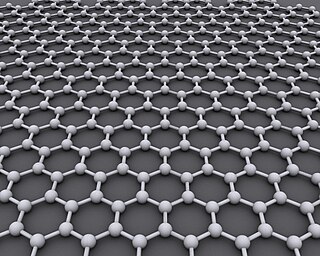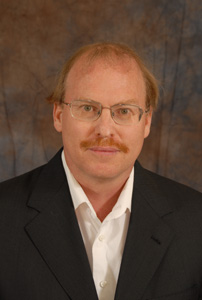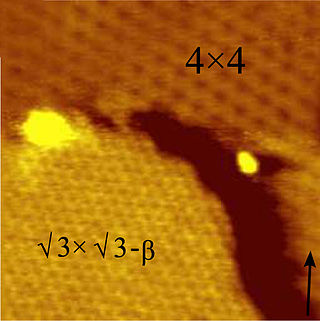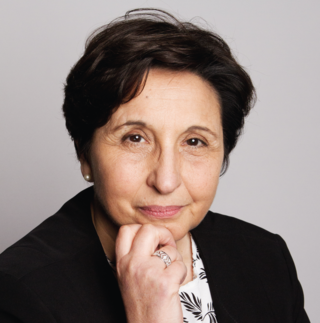Related Research Articles

Graphene is a carbon allotrope consisting of a single layer of atoms arranged in a honeycomb planar nanostructure. The name "graphene" is derived from "graphite" and the suffix -ene, indicating the presence of double bonds within the carbon structure.

James Mitchell Tour is an American chemist and nanotechnologist. He is a Professor of Chemistry, Professor of Materials Science and Nanoengineering at Rice University in Houston, Texas.

Surface-enhanced Raman spectroscopy or surface-enhanced Raman scattering (SERS) is a surface-sensitive technique that enhances Raman scattering by molecules adsorbed on rough metal surfaces or by nanostructures such as plasmonic-magnetic silica nanotubes. The enhancement factor can be as much as 1010 to 1011, which means the technique may detect single molecules.

Graphene nanoribbons are strips of graphene with width less than 100 nm. Graphene ribbons were introduced as a theoretical model by Mitsutaka Fujita and coauthors to examine the edge and nanoscale size effect in graphene.

A topological insulator is a material whose interior behaves as an electrical insulator while its surface behaves as an electrical conductor, meaning that electrons can only move along the surface of the material.

Rodney S. "Rod" Ruoff is an American physical chemist and nanoscience researcher. He is one of the world experts on carbon materials including carbon nanostructures such as fullerenes, nanotubes, graphene, diamond, and has had pioneering discoveries on such materials and others. Ruoff received his B.S. in chemistry from the University of Texas at Austin (1981) and his Ph.D. in chemical physics at the University of Illinois-Urbana (1988). After a Fulbright Fellowship at the MPI fuer Stroemungsforschung in Goettingen, Germany (1989) and postdoctoral work at the IBM T. J. Watson Research Center (1990–91), Ruoff became a staff scientist in the Molecular Physics Laboratory at SRI International (1991–1996). He is currently UNIST Distinguished Professor at the Ulsan National Institute of Science and Technology (UNIST), and the director of the Center for Multidimensional Carbon Materials, an Institute for Basic Science Center located at UNIST.
In physics, the plasmaron was proposed by Lundqvist in 1967 as a quasiparticle arising in a system that has strong plasmon-electron interactions. In the original work, the plasmaron was proposed to describe a secondary peak in the photoemission spectral function of the electron gas. More precisely it was defined as an additional zero of the quasi-particle equation . The same authors pointed out, in a subsequent work, that this extra solution might be an artifact of the used approximations:
We want to stress again that the discussion we have given of the one-electron spectrum is based on the assumption that vertex corrections are small. As discussed in the next section recent work by Langreth [29] shows that vertex corrections in the core electron problem can have a quite large effect on the form of satellite structures, while their effect on the quasi particle properties seems to be small. Preliminary investigations by one of us (L.H.) show similar strong vertex effects on the conduction band satellite. The details of the plasmaron structure should thus not be taken very seriously.

Silicene is a two-dimensional allotrope of silicon, with a hexagonal honeycomb structure similar to that of graphene. Contrary to graphene, silicene is not flat, but has a periodically buckled topology; the coupling between layers in silicene is much stronger than in multilayered graphene; and the oxidized form of silicene, 2D silica, has a very different chemical structure from graphene oxide.
Bilayer graphene is a material consisting of two layers of graphene. One of the first reports of bilayer graphene was in the seminal 2004 Science paper by Geim and colleagues, in which they described devices "which contained just one, two, or three atomic layers"

Transition-metal dichalcogenide (TMD or TMDC) monolayers are atomically thin semiconductors of the type MX2, with M a transition-metal atom (Mo, W, etc.) and X a chalcogen atom (S, Se, or Te). One layer of M atoms is sandwiched between two layers of X atoms. They are part of the large family of so-called 2D materials, named so to emphasize their extraordinary thinness. For example, a MoS2 monolayer is only 6.5 Å thick. The key feature of these materials is the interaction of large atoms in the 2D structure as compared with first-row transition-metal dichalcogenides, e.g., WTe2 exhibits anomalous giant magnetoresistance and superconductivity.
In materials science, the term single-layer materials or 2D materials refers to crystalline solids consisting of a single layer of atoms. These materials are promising for some applications but remain the focus of research. Single-layer materials derived from single elements generally carry the -ene suffix in their names, e.g. graphene. Single-layer materials that are compounds of two or more elements have -ane or -ide suffixes. 2D materials can generally be categorized as either 2D allotropes of various elements or as compounds.

Bernard Lucas "Ben" Feringa is a Dutch synthetic organic chemist, specializing in molecular nanotechnology and homogeneous catalysis.
Jürgen P. Rabe is a German physicist and nanoscientist.
A rapidly increasing list of graphene production techniques have been developed to enable graphene's use in commercial applications.
Hrvoje Petek is a Croatian-born American physicist and the Richard King Mellon Professor of Physics and Astronomy, at the University of Pittsburgh, where he is also a professor of chemistry.

Alessandra Lanzara is an Italian-American physicist and the distinguished Charles Kittel Professor of physics at the University of California, Berkeley since 2002, where she leads an experimental materials physics group. She is the founding director of Center for Sustainable Innovation at UCB and the co-founder of Quantum Advanced Detection (QUAD) LLC.
Nathalie Helene Katsonis is a Professor of Active Molecular Systems at the Stratingh Institute for Chemistry, University of Groningen. In 2016 she was awarded the Royal Netherlands Chemical Society Gold Medal.
In physics and chemistry, photoemission orbital tomography is a combined experimental / theoretical approach which was initially developed to reveal information about the spatial distribution of individual one-electron surface-state wave functions and later extended to study molecular orbitals. Experimentally, it uses angle-resolved photoemission spectroscopy (ARPES) to obtain constant binding energy photoemission angular distribution maps. In their pioneering work, Mugarza et al. in 2003 used a phase-retrieval method to obtain the wave function of electron surface states based on ARPES data acquired from stepped gold crystalline surfaces; they obtained the respective wave functions and, upon insertion into the Schrödinger equation, also the binding potential. More recently, photoemission maps, also known as tomograms, have been shown to reveal information about the electron probability distribution in molecular orbitals. Theoretically, one rationalizes these tomograms as hemispherical cuts through the molecular orbital in momentum space. This interpretation relies on the assumption of a plane wave final state, i.e., the idea that the outgoing electron can be treated as a free electron, which can be further exploited to reconstruct real-space images of molecular orbitals on a sub-Ångström length scale in two or three dimensions. Presently, POT has been applied to various organic molecules forming well-oriented monolayers on single crystal surfaces or to two-dimensional materials.

Maria C. Asensio is a Spanish-Argentinian physical chemist, academic, researcher, and author. She is a Full Research Professor at the Materials Science Institute of Madrid (ICMM) of the Spanish National Research Council (CSIC) and Chair of the CSIC Research Associated Unit-MATINÉE created between the ICMM and the Institute of Materials Science (ICMUV) of the Valencia University.
Nano Angle-Resolved Photoemission Spectroscopy (Nano-ARPES), is a variant of the experimental technique ARPES. It has the ability to precisely determine the electronic band structure of materials in momentum space with submicron lateral resolution. Due to its demanding experimental setup, this technique is much less extended than ARPES, widely used in condensed matter physics to experimentally determine the electronic properties of a broad range of crystalline materials. Nano-ARPES can access the electronic structure of well-ordered monocrystalline solids with high energy, momentum, and lateral resolution, even if they are nanometric or heterogeneous mesoscopic samples. Nano-ARPES technique is also based on Einstein's photoelectric effect, being photon-in electron-out spectroscopy, which has converted into an essential tool in studying the electronic structure of nanomaterials, like quantum and low dimensional materials.
References
- 1 2 "Curriculum Vitae of prof. dr. P. (Petra) Rudolf | How to find us | About us | University of Groningen". www.rug.nl. 4 December 2012. Retrieved 17 March 2019.
- ↑ "Public Lectures on Gender, Science and Technology". Utrecht University. 13 April 2015. Retrieved 17 March 2019.
- ↑ Rudolf, P.; de Graaf, N.; Koornstra, R.-A.; van Tijn, P.; Kool, D. (2015). "Women in physics in the Netherlands: Progress and developments" (PDF). AIP Conference Proceedings. 1697 (1): 060033. Bibcode:2015AIPC.1697f0033R. doi:10.1063/1.4937680.
- ↑ "NNV Diversity Prize 2018 awarded to Groningen | e-EPS". www.epsnews.eu. Retrieved 17 March 2019.
- ↑ "EPS Council 2018: Petra Rudolf is the next EPS President-elect". www.eps.org. Retrieved 17 March 2019.
- ↑ "EPS Council 2020: Luc Bergé is the next EPS President-elect". www.eps.org. 2020-06-09. Retrieved 22 October 2023.
- ↑ "Award ceremony of the SPS-ÖPG joint annual meeting 2023: EPS Emmy Noether Distinction 2022 for outstanding physicists". www.eps.org. 2023-09-15. Retrieved 22 October 2023.
- ↑ "Petra Rudolf – Google Scholar Citations". scholar.google.com. Retrieved 1 April 2019.
- ↑ Stathi, P.; Gournis, D.; Deligiannakis, Y.; Rudolf, P. (2015). "Stabilization of Phenolic Radicals on Graphene Oxide: An XPS and EPR Study" (PDF). Langmuir. 31 (38): 10508–10516. doi:10.1021/acs.langmuir.5b01248. PMID 26280685. S2CID 45029751.
- ↑ Monazami, E.; Bignardi, L.; Rudolf, P.; Reinke, P. (2015). "Strain Lattice Imprinting in Graphene by C60 Intercalation at the Graphene/Cu Interface" (PDF). Nano Letters. 15 (11): 7421–30. Bibcode:2015NanoL..15.7421M. doi:10.1021/acs.nanolett.5b02851. PMID 26426671. S2CID 206728360.
- ↑ Tognolini, S.; Pagliara, S.; Bignardi, L.; Ponzoni, S.; Rudolf, P.; Parmigiani, F. (2016). "Surface states resonances at the single-layer graphene/Cu(111) interface" (PDF). Surface Science. 643: 210–213. Bibcode:2016SurSc.643..210T. doi:10.1016/j.susc.2015.06.021. S2CID 93961093.
- ↑ Stamatis, H.; Rudolf, P.; Gournis, D.; Kouloumpis, A.; Patila, M. (2016). "Laccase-Functionalized Graphene Oxide Assemblies as Efficient Nanobiocatalysts for Oxidation Reactions". Sensors. 16 (3): 287. Bibcode:2016Senso..16..287P. doi: 10.3390/s16030287 . PMC 4813862 . PMID 26927109.
- ↑ Kouloumpis, A.; Vourdas, N.; Zygouri, P.; Chalmpes, N.; Potsi, G.; Kostas, V.; Spyrou, K.; Stathopoulos, V.N.; Gournis, D.; Rudolf, P. (2018). "Controlled deposition of fullerene derivatives within a graphene template by means of a modified Langmuir-Schaefer method" (PDF). Journal of Colloid and Interface Science. 524: 388–398. Bibcode:2018JCIS..524..388K. doi:10.1016/j.jcis.2018.04.049. PMID 29674283. S2CID 4973695.
- ↑ "Breakthrough may lead to industrial production of graphene devices". phys.org. Retrieved 17 March 2019.
- ↑ "First transport measurements reveal intriguing properties of germanene". ScienceDaily. Retrieved 17 March 2019.
- ↑ "Playing Lego with 2D crystals: exfoliation and intercalation strategies to put 2D crystals on surfaces and to produce pillared structures". Universitetet i Bergen (in Norwegian Bokmål). Retrieved 17 March 2019.
- ↑ Madhushankar, B. N.; Kaverzin, A.; Giousis, T.; Potsi, G.; Gournis, D.; Rudolf, P.; Blake, G. R.; Wal, C. H. van der; Wees, B. J. van (2017). "Electronic properties of germanane field-effect transistors". 2D Materials. 4 (2): 021009. Bibcode:2017TDM.....4b1009M. doi: 10.1088/2053-1583/aa57fd . ISSN 2053-1583.
- ↑ Chen, Q.; Liang, L.; Potsi, G.; Wan, P.; Lu, J.; Giousis, T.; Thomou, E.; Gournis, D.; Rudolf, P.; Ye, J. (2019). "Highly Conductive Metallic State and Strong Spin–Orbit Interaction in Annealed Germanane". Nano Letters. 19 (3): 1520–1526. Bibcode:2019NanoL..19.1520C. doi:10.1021/acs.nanolett.8b04207. PMC 6421576 . PMID 30674194.
- ↑ Coşkuner Filiz, B.; Gnanakumar, E. S.; Martínez-Arias, A.; Gengler, R.; Rudolf, P.; Rothenberg, G.; Shiju, N. R. (2017). "Highly Selective Hydrogenation of Levulinic Acid to γ-Valerolactone Over Ru/ZrO2 Catalysts" (PDF). Catalysis Letters. 147 (7): 1744–1753. doi:10.1007/s10562-017-2049-x. ISSN 1572-879X. S2CID 98955716.
- ↑ Cepek, C.; Rudolf, P.; Milošević, M. V.; Peeters, F. M.; Oppeneer, P. M.; Partoens, B.; Petaccia, L.; Gorovikov, S.; Mattevi, C.; Abswoude, P. van; Aperis, A.; Bignardi, L.; Bekaert, J. (2017). "Free surfaces recast superconductivity in few-monolayer MgB 2 : Combined first-principles and ARPES demonstration". Scientific Reports. 7 (1): 14458. Bibcode:2017NatSR...714458B. doi:10.1038/s41598-017-13913-z. ISSN 2045-2322. PMC 5663715 . PMID 29089566.
- ↑ M. Palstra, T. T.; Besenbacher, F.; Groot, R. A. de; R. Blake, G.; Rudolf, P.; Wu, J.; Rao, J.; Su, R.; Li, G. (2016). "Band gap narrowing of SnS 2 superstructures with improved hydrogen production". Journal of Materials Chemistry A. 4 (1): 209–216. doi:10.1039/C5TA07283B. S2CID 262002913 . Retrieved 1 April 2019.
- ↑ Carroll, G. T.; London, G.; Landaluce, T. F.; Rudolf, P.; Feringa, B. L. (2011). "Adhesion of Photon-Driven Molecular Motors to Surfaces via 1,3-Dipolar Cycloadditions: Effect of Interfacial Interactions on Molecular Motion" (PDF). ACS Nano. 5 (1): 622–630. doi:10.1021/nn102876j. PMID 21207983. S2CID 39105918.
- ↑ Chen, K.-Y.; Ivashenko, O.; Carroll, G. T.; Robertus, J.; Kistemaker, J. C. M.; London, G.; Browne, W. R.; Rudolf, P.; Feringa, B. L. (2014). "Control of Surface Wettability Using Tripodal Light-Activated Molecular Motors". Journal of the American Chemical Society. 136 (8): 3219–3224. Bibcode:2014JAChS.136.3219C. doi:10.1021/ja412110t. ISSN 0002-7863. PMID 24490770. S2CID 207106544.
- ↑ "Petra Rudolf appointed APS fellow". NWO-I. 16 December 2010. Retrieved 17 March 2019.
- ↑ "APS Fellow Archive". www.aps.org. Retrieved 17 March 2019.
- ↑ "European Commission – PRESS RELEASES – Press release – The European Science Awards". europa.eu. Retrieved 17 March 2019.
- ↑ "Descartes-prijs voor Petra Rudolf en Wybren Jan Buma". NWO-I (in Dutch). 13 March 2008. Retrieved 17 March 2019.
- ↑ Zerbetto, F.; Teobaldi, G.; Rudolf, P.; Mendoza, S. M.; Lubomska, M.; Leigh, D. A.; Berná, J. (2005). "Macroscopic transport by synthetic molecular machines" (PDF). Nature Materials. 4 (9): 704–710. Bibcode:2005NatMa...4..704B. doi:10.1038/nmat1455. hdl: 11370/f6ec5cba-c5fe-4041-afbf-3e2f74a7d376 . ISSN 1476-4660. PMID 16127455. S2CID 1680720.
- ↑ "RTVOOG Koninklijke onderscheiding voor dertien Stadjers". 26 April 2013. Retrieved 17 March 2019.
- ↑ "Lintjesregen in Groningen". RTV Noord (in Dutch). Retrieved 17 March 2019.
- ↑ "Royal decoration for Petra Rudolf | News archive | News | News and Events | About us | University of Groningen". www.rug.nl. Retrieved 17 March 2019.
- ↑ "Petra Rudolf University of Groningen". acatech – National Academy of Science and Engineering. Retrieved 2019-08-08.
- ↑ "Petra Rudolf". Members. Academia Europaea. Retrieved 2021-12-18.